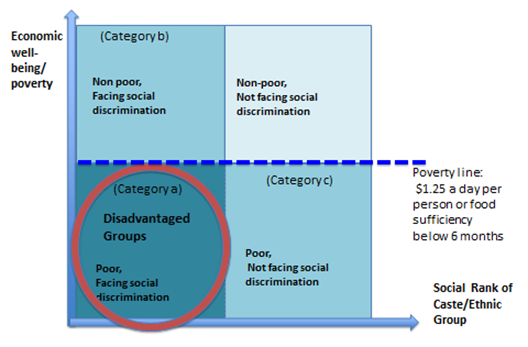« back
Targeting Reviewed
 July 2017 / Barbara Weyermann, Programme Manager, Embassy of Switzerland in Nepal
July 2017 / Barbara Weyermann, Programme Manager, Embassy of Switzerland in NepalSocial discrimination and economic deprivation of a large majority of the population fuelled the armed conflict between the Maoist insurgents and the Nepali state (1996-2006). SDC Nepal responded with interventions designed to better reach out to disadvantaged groups. Slowly, a concept for systematic beneficiary targeting emerged. A decade into this practice, SDC Nepal commissioned a review of the targeting approach.
The Targeting Approach
For the last two strategy periods, from 2009 to 2017, SDC Nepal has made the firm commitment that 60% of its beneficiaries belong to disadvantaged groups (DAG) and 50% are women. DAGs are defined as economically poor (land/income) and socially discriminated because of the caste system or ethnic origin.
Graph: Targeting concept

The selection of the targeted households has been based on data collected by the Government of Nepal (GoN). The decision to use official data was made to reduce the transaction costs for people and projects and to avoid the confusion that is created when a multitude of actors categorise households according to different methods. The Ministry of Federal Affairs and Local Development (MoFALD) adopted the Underlying Causes of Poverty Analysis (UCPA) after the SDC had piloted this method in one district. The UCPA is a community based approach to identify the poor (1).
Major Findings of the Review
The review team found that the rationale for targeting has been well internalised by embassy and project staff. However, the targeting practice of the projects often did not follow the guidelines. Projects did not trust the UCPA data and carried out their own well-being ranking. Many projects went to deprived geographic areas and selected people according to the name which denotes a persons’ caste/ethnicity. They found this easier and quicker than taking into account the combination of social identity and economic status. The targeting process was often hurried and poorly communicated to the community.
Flaws of the Baseline Data and Capacity Constraints of Staff
In most districts where the SDC has not supported the government to collect data, household lists were unavailable or inaccurate. The government has not invested sufficient resources to make targeting work. The governments’ social mobilisers responsible for the poverty ranking received very little training; they also were from the same communities as the people they tried to categorise and hence were at times unable to restrain the elites from dominating the process. Moreover, the data, where it exists, is five years old and the poverty status of many has changed in the meantime.
The SDC initially invested considerable resources to define and refine the targeting concept and to train and guide SDC and project staff. But a few years into the practice, the efforts to support correct targeting became negligible.
People’s Response to Targeting
In spite of all these gaps and flaws, the review team found people to be highly satisfied with Swiss interventions; hardly any grievances and no major conflicts related to targeting were reported. The following reasons could be responsible for this outcome: The communities accept that differences between people exist and that, to make up for it, the poor should receive more benefits. People agree with the community-based methodology and approve to include the elite in the well-being ranking as long as they do not unduly influence the process. The Swiss formula of 60% - 40% allows members of dominant groups to participate in the project and ensures their buy-in. If the individual economic gain is very big, such as in the infrastructure projects, almost everybody in a selected geographic area benefits.
Way Forward
In a context of persisting poverty and social exclusion, the SCS 2018-2021 commits to continue with targeting. But instead of setting an overall blanket target of 60% DAG and 50% women, each project will identify a quantitative objective relevant for its specific outcomes. Moreover, each project will also define measures to reduce obstacles for poor, discriminated people and women to increase their capacity/agency for participation in social and political processes. The Embassy will invest more resources into capacitating staff for targeting and in supporting local governments with the collection of accurate data. Tendering processes must take these ambitious objectives better into account. Professional and realistic targeting is critical for the formulation of social and economic policies well beyond the boundaries of SDC financed projects.
(1) The most important UCPA tools are social & resource mapping and well-being ranking in front of the whole community. The UCPA identifies DAG households as well as the most deprived geographic areas in each local government unit.
Sources:
Schüring Esther and Jeevan Lohani (2017). Assessment of the Swiss Embassy/Swiss Development Cooperation (SDC) Present and Future Targeting Approaches and Practices in Nepal. Kathmandu/Nepal.
